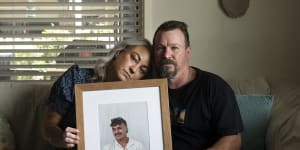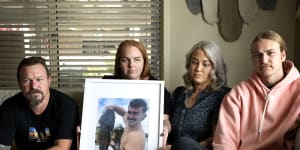Two hours later,Chater peered into her son’s bedroom to find him convulsing on the floor,unresponsive and unable to speak. Soon she was in the car,trailing an ambulance on the way to Wollongong Hospital,where doctors pulled her into a room and told her that Brayden was brain-dead. He had just turned 23.

Stacey and Ralph Chater are facing a second Christmas without their son Brayden,who died at just 23 after contracting meningococcal B.Louise Kennerley
In the blur of the days following his death,doctors called Chater to tell her Brayden had died from meningococcal B.
“I never knew there was a strain of meningococcal[disease] that my children weren’t vaccinated against – or that the vaccine existed,” she said. “I try really hard to be positive and remember good things and how lucky I was to have him for 23 years.”
Chater is pushing for NSW to follow South Australia and Queensland in making the vaccine – which can cost more than $200 for two doses – free for children under two years and teenagers between 15 and 19.
All year 10 students in NSW are offered a vaccine protecting them against meningococcal strains A,C,W and Y,but not the vaccine protecting against meningococcal B – the most prevalent form of the deadly disease.
The vaccine has been free for First Nations children and for people of all ages with certain immune conditions since 2019,when the Pharmaceutical Benefits Advisory Committee (PBAC) recommended its inclusion on the national immunisation program.
The committee did not recommend its inclusion for infants and adolescents,estimating it would cost the government $400 million a year to prevent around 224 cases of the disease. It also cast doubt on the duration and effectiveness of the vaccine.

The Chater family – Ralph,Shayne,Stacey and Harry – with a photo of son and brother Brayden.Louise Kennerley
In response to questions,a NSW government spokesman said Health Minister Ryan Park had written to his federal counterpart Mark Butler asking him to request the committee reconsider extending the eligibility for free meningococcal B vaccines.
Butler did not respond to questions,but a spokesman for the Department of Health and Aged Care said the PBAC was “an independent,expert advisory body that must give consideration to the effectiveness and cost of immunisation involving the use of the vaccine”.
There have been 35 cases of meningococcal disease in NSW so far this year,27 of which were the meningococcal B strain. Nationally,there have been 137 cases,an increase on the 125 reported last year.
Meningitis Centre Australia chief executive Karen Quick said many parents were not aware of a vaccine guarding against the disease,and others could not afford the $200 outlay.
“Nobody should have to make that choice between protecting their kids and putting food on the table,” she said.
Professor Robert Booy,an infectious disease paediatrician at the University of Sydney,said that affordability was an issue for some people,but there was “a big difference between a few hundred dollars and being damaged” or killed by the disease.
All strains of meningococcal disease are polysaccharides,meaning they are protected by a layer of sugar in the outer membrane. But the structure of the coating in the B strain is so similar to a protein in the human brain that the body refuses to make an immune response,Booy said.
Because it needs to act against proteins that sit under the sugar coating,it has been more difficult to create a vaccine against the B strain. The vaccine has only been available in Australia since 2013.
Neither state nor federal agencies track meningococcal deaths. A 50-year-old Sydney resident in June,while two people – including a one-year-old – were in the same month.
Booy said the risk of contracting meningococcal disease increases during summer,when people come together for family gatherings,festivals,and return to university and school campuses.
The bacteria can be carried in the throat without symptoms,but is passed on to others through coughing,kissing and singing in crowded spaces.
Start the day with a summary of the day’s most important and interesting stories,analysis and insights..